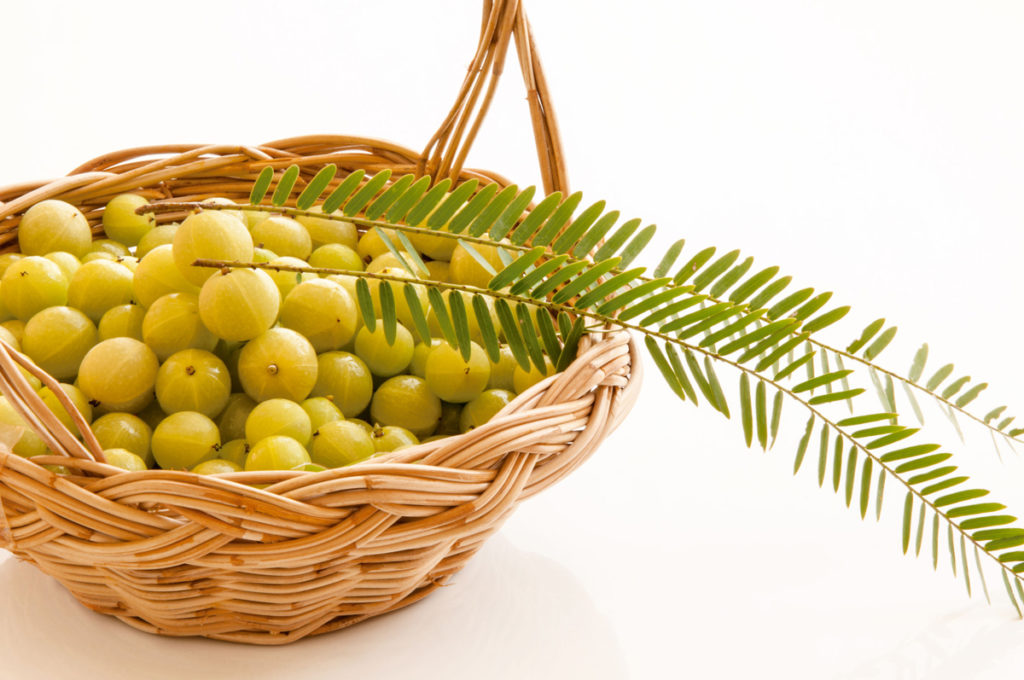Haritaki, known by the vernacular names Harad in Hindi, Kadukkai in Tamil, Karakkaya in Telugu and Indian hog plum in English is one of the three rejuvenating herbs that constitute the miraculous Triphala formulation.
Also referred as “chebulic myrobalan”, it is the dried fruit of the Haritaki tree which goes by the botanical name Terminalia chebula and is native to India but also widely distributed in China, Nepal and Srilanka. Haritaki is generally used in the dried powdered form and has a distinct brownish-black colour and oblong in shape.
Coined as the “king of herbs” by many ayurvedic healers, this miraculous fruit holds great significance in the holistic healing of ayurveda and is extensively used for curing various ailments due to its laxative, astringent, purgative, anti-bilious and anti-oxidant nature.
Depending upon the habitat and shape there are seven types of haritaki available in India mainly, Jayanti Haritaki, Abhaya Haritaki, Amrita Haritaki, Putna Haritaki, Rohini Haritaki, Vijaya Haritaki, Chetaki Haritaki.
Haritaki characterizes all five tastes mainly Katu (i.e. pungent), Tikta (i.e. bitter), Kashaya (i.e. astringent), Madhur (i.e. sweet) and Amla (i.e. sour). It has Laghu and Rukhsha Guna (i.e. light and dry property), Tikshna Virya (hot potency) and Madhura Vipaka (i.e. sweet after digestion).
Ways To Take Haritaki In Different Seasons:
Haritaki is usually available in powdered form and has to be taken by infusing it in warm water or in the form of a decoction or tea. Try to take this powder in the specified way given below to reap its benefits.
In autumn, it can be ingested with desi kand or mishri.
In summers, it can be taken along with jaggery.
In early winters, try to consume it with ginger, and in late winters take it alongside long pepper (gaja pippali).
In autumn season, consume it with natural or flavoured honey to reap its benefits.
But if the entire regimen is hard to follow throughout the year, you can consume haritaki with just honey or long pepper.
Health Benefits of Haritaki
Promotes Digestion
Being a potent digestive, haritaki is enormously beneficial in improving the digestive functions of the body by increasing the absorption of essential nutrients from the food. The powdered fruit also has a mild laxative effect on the body and hence treats constipation by decreasing flatulence, cleansing the intestines and removing waste products from the body. It is also extremely effective in reducing stomach acidity and minimalizing the chances of various stomach ulcers.
Enhances Weight Loss
Addition of this herb to your daily diet not only improves digestion but also plays a key role in reducing obesity. It effectively detoxifies the body by removing AMA toxins (Ama is the toxic product of improperly digested food. It blocks the subtle channels of the body, disturbs digestion and attracts localized imbalances of the Doshas that may give rise to disease) and reduces sudden hunger pangs and a craving for unhealthy dietary choices. A glass of warm water infused with haritaki powder and honey not only sheds away the fat deposits but also energizes the body and promotes longevity.
Manages Diabetes
Several scientific researches strongly advocate the use of haritaki for managing diabetes and keeping the blood sugar levels under control. The production of insulin from the pancreatic β-cells become active on consumption of the haritaki powder. It also helps to reduce the breakdown of starch into glucose which in turn regulates the secretion of insulin and leads to low blood glucose level.
Improves Oral Hygiene
Haritaki is traditionally used as a mouthwash for treating and curing various problems related to oral hygiene like gum disease, mouth ulcers, oral sores. The potent anti-bacterial nature of this herb makes it highly significant in alleviating bacterial invasion from the oral cavities thereby preventing cavities and tooth decay.
Good For Skin And Hair
The excellent antibacterial and antioxidative nature of this powerful herb promotes overall skin and hair health and is strongly advised for various skin infections like acne, pimples, rashes, boils etc. It is also useful in treating scalp infections like dandruff, itching and hair fall. Application of haritaki paste on the affected area can speed up wound healing and cure acne and pimples and also prevent further breakouts.
Effect On Doshas
The miraculous herb balances all the three doshas mainly Vata (i.e. air), Pitta (i.e. digestion) and Kapha (i.e. earth and water).
Adverse Effects
Although, haritaki is extremely beneficial for the health and has a host of therapeutic benefits, overconsumption or consuming without consultation with an ayurvedic doctor or healer might cause dehydration, diarrhoea, fatigue or leave a prolonged bitter after taste. Hence, it is always advisable to consult a doctor before consuming haritaki supplements or using the powder regularly.
Conclusion:
The incredible fruit in its dried powdered form holds high significance in treating a myriad of health benefits including indigestion, gastritis, lung disease, obesity, dental problems, jaundice, impotency--*, cough, cold, asthma, vision defects, urinary tract infections and hair and skin problems. Haritaki is available in various forms and can be ingested in all the seasons by infusing it with different additives. Try to take it in specified dosage *-after a proper consultation with the doctor.







